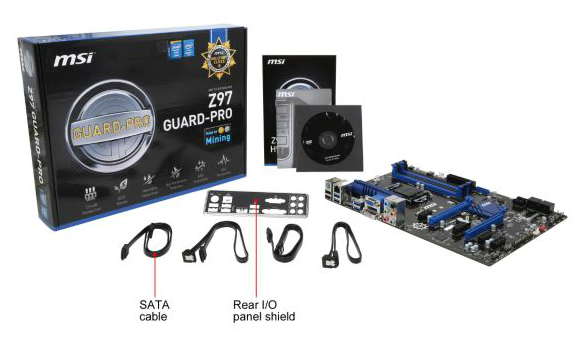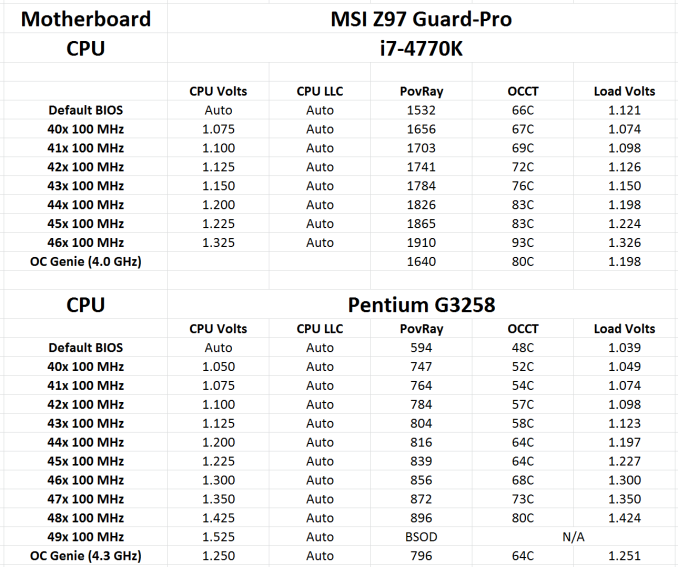MSI Z97 Guard-Pro Review: Entry Level Z97 at $110
by Ian Cutress on August 20, 2014 6:00 AM EST- Posted in
- Motherboards
- Intel
- MSI
- Z97
MSI Z97 Guard-Pro In The Box
Like the other low cost motherboards we have seen, especially in our $140 mini-ITX roundup, bundles for cost-conscious products are relatively thin. When there are less features on the board, there is less of an opportunity to add extras, but also there tends to be minimal branding for other bundled items, such as the door hanger in MSI’s gaming range.
In the MSI Z97 Guard-Pro we get the following:
Driver Disk
Manual
Rear IO Shield
Four SATA Cables
Four SATA cables are relatively unexpected, I would have thought two but this is a nice surprise.
Many thanks to...
We must thank the following companies for kindly providing hardware for our test bed:
Thank you to OCZ for providing us with PSUs and SSDs.
Thank you to G.Skill for providing us with memory.
Thank you to Corsair for providing us with an AX1200i PSU and a Corsair H80i CLC.
Thank you to MSI for providing us with the NVIDIA GTX 770 Lightning GPUs.
Thank you to Rosewill for providing us with PSUs and RK-9100 keyboards.
Thank you to ASRock for providing us with some IO testing kit.
Test Setup
| Test Setup | |
| Processor |
Intel Core i7-4770K ES 4 Cores, 8 Threads, 3.5 GHz (3.9 GHz Turbo) |
| Motherboard | MSI Z97 Guard-Pro |
| Cooling |
Corsair H80i Thermalright TRUE Copper |
| Power Supply |
OCZ 1250W Gold ZX Series Corsair AX1200i Platinum PSU |
| Memory | G.Skill RipjawsZ 4x4 GB DDR3-1600 9-11-9 Kit |
| Memory Settings | 1600 9-11-9-27 1T tRFC 240 |
| Video Cards | MSI GTX 770 Lightning 2GB (1150/1202 Boost) |
| Video Drivers | NVIDIA Drivers 337 |
| Hard Drive | OCZ Vertex 3 256GB |
| Optical Drive | LG GH22NS50 |
| Case | Open Test Bed |
| Operating System | Windows 7 64-bit SP1 |
| USB 2/3 Testing | OCZ Vertex 3 240GB with SATA->USB Adaptor |
MSI Z97 Guard-Pro Overclocking
Experience with MSI Z97 Guard-Pro
One argument for Intel’s chipset segregation (Z97, H97, H81, B85 etc.) is that boards not oriented towards overclocking can save some money and buy a cheaper chipset. Because MSI went with the Z97 here, overclocking should be one of the main features. When MSI and I discussed the motherboard, they promoted it as a nice cheaper board for overclocking the Pentium G3258, and to push the point they provided a good G3258 to let me test the legs of the system.
Our G3258 sample from MSI went to 4.8 GHz at 1.425 volts, giving an 80ºC peak temperature, which is rather impressive and indicates that no matter how good/bad your CPU might be the Z97 Guard-Pro should be a low cost option for air/water overclocking. MSI’s auto overclocking (via OC Genie) pushed the CPU from 3.2 GHz to 4.3 GHz, giving a healthy +1100 MHz with a single option change.
We also went in with our regular i7-4770K CPU for overclocking, and it hit 4.6 GHz at 93C. This temperature at 4.6 GHz is a little high compared to our best results, but in line with some of our other Z97 motherboards.
It is worth noting one issue we had during testing: if the CPU voltage was not sufficient, it would be a pain to get into the BIOS in order to add additional voltage as the system would hang. As a result, this meant more often than not I would need to reset the BIOS and put in all my options again. This stems from the fact that the board implements the CPU frequency and voltage during POST, rather than right at the end like some other motherboards.
Methodology
Our standard overclocking methodology is as follows. We select the automatic overclock options and test for stability with PovRay and OCCT to simulate high-end workloads. These stability tests aim to catch any immediate causes for memory or CPU errors.
For manual overclocks, based on the information gathered from previous testing, starts off at a nominal voltage and CPU multiplier, and the multiplier is increased until the stability tests are failed. The CPU voltage is increased gradually until the stability tests are passed, and the process repeated until the motherboard reduces the multiplier automatically (due to safety protocol) or the CPU temperature reaches a stupidly high level (100ºC+). Our test bed is not in a case, which should push overclocks higher with fresher (cooler) air.
Overclock Results












41 Comments
View All Comments
spugm1r3 - Wednesday, August 20, 2014 - link
http://www.legitreviews.com/intel-pentium-g3258-du...That shows a pretty robust selection of recent AAA titles faring as well on a Pentium as they do on an i7. Not all 2014 games are multithreaded. In fact, a vast majority aren't utilizing the resources offered by higher end processors. My point is, as long as Crysis or RTS games like Civ5 aren't your mainstays, invest the extra dollars where it counts.
Flunk - Wednesday, August 20, 2014 - link
Some of the benchmarks you linked to are as much as 40% slower on the overclocked Pentium, that's not what most people would call "on par". You're also discounting the fact that the 4770K overclocked would perform significantly better (Apples to apples here, if we've otherclocking we need to do it to both chips).The Pentium AE is a good low-end deal that will do for a lot of games, add in a mid-range GPU like a Radeon 270x or 280x and you've got a lot of performance for the buck. But it isn't comparable to even an overclocked i5 performance wise.
hojnikb - Wednesday, August 20, 2014 - link
If you want price/performance for games, then you either get athlon 750/760K, fx6300, i3 or i5.Everything else makes little sense and its a waste of money.
PentiumK and a z97 only makes sense if you're buying a stopgap system, that will soon get a better CPU. Buying pentiumK for longterm and expection to perform great is just crazy. FFS, its a lowend 2 core cpu.
DanNeely - Wednesday, August 20, 2014 - link
None of the benches they showed that actually matter are. No one uses a high end GPU to play at low quality settings and >200 FPS. That sort of BOGO benching to try and show CPU differences has been as stupid as it is common for a number of years. The ones at realistic GPU settings (1080p/max) were all within a few FPS of each other.If they wanted to try and show situations where the CPU mattered, min FPS or frame rate pacing data might work since both would capture any times where the CPU briefly did become a bottleneck. Alternately benches for games like CIV5 that do have major multi-threaded CPUbound functions would give the 4790 the ability to crush the pentium.
Medium term, I'm less confident that most games will only need 1 or 2 CPU threads will remain a valid assumption. The current generation of consoles have 8 slow CPUs vs prior generations having a few fast ones (and the PS3's secondary cores limitations making them harder to use). That's going to put more multi-threading pressure on the game engine developers; and makes commonly used engines being able to effectively use more than a handful of threads more likely in the future.
zero2dash - Wednesday, August 20, 2014 - link
^^^ This.G3258 is a good basic CPU, but there are plenty of reviews that show that it is nowhere near "on par" with an i5 (let alone an i7) in games. In some reviews, even an i3 does better than the G3258.
Intel needs to release an i3-K chip; that's all that the G3258 has demonstrated. It's a decent chip, especially when bundled with the MSI board for $100 at Microcenter, but, it's not "on par" with anything higher in Intel's product line on games (or anything, really).
austinsguitar - Wednesday, August 20, 2014 - link
umm... cheepo xeon ftw....Samus - Wednesday, August 20, 2014 - link
With AMD making quad core CPU's for $50, multithreaded software is becoming increasingly commonplace. Clock speed means little to modern software; specialized instructions and multithreaded performance mean everything, not to just AAA games. If you're playing 5 year old games, sure, but then why are you building a new PC for them in the first place?I've upgraded Pentium and Celeron PC's to i3's in offices and people even mention how much faster their Outlook and web browsing is, with the only real difference being hyper threading and cache.
xenol - Wednesday, August 20, 2014 - link
Games have always used more than two threads. I fired up Rainbow Six 3 the other day and found it had 12 threads going.Samus - Wednesday, August 20, 2014 - link
A Pentium K at 4.7GHz is comparable to an i3 at 3.4GHz (stock) in multithreaded tasks, which in 2014, is everything. The i3 costs $30 more and doesn't need to be overclocked. Or you could just get an i5 with an H-series motherboard and have more performance than the Pentium K could every achieve for a few dollars more.just4U - Thursday, August 21, 2014 - link
I use a 4790K for my main system. I also use a A10-5800 and a Non OC Pentium G3258. All systems have comparable specs (ram/ssd) When it comes to browsing the web, opening emails and using office programs I typically use.. I haven't noticed a difference.I actually don't really notice a difference until I head down to Dual Cores in the C2D 6x lineup below 3GHZ. I think their finally showing their age.